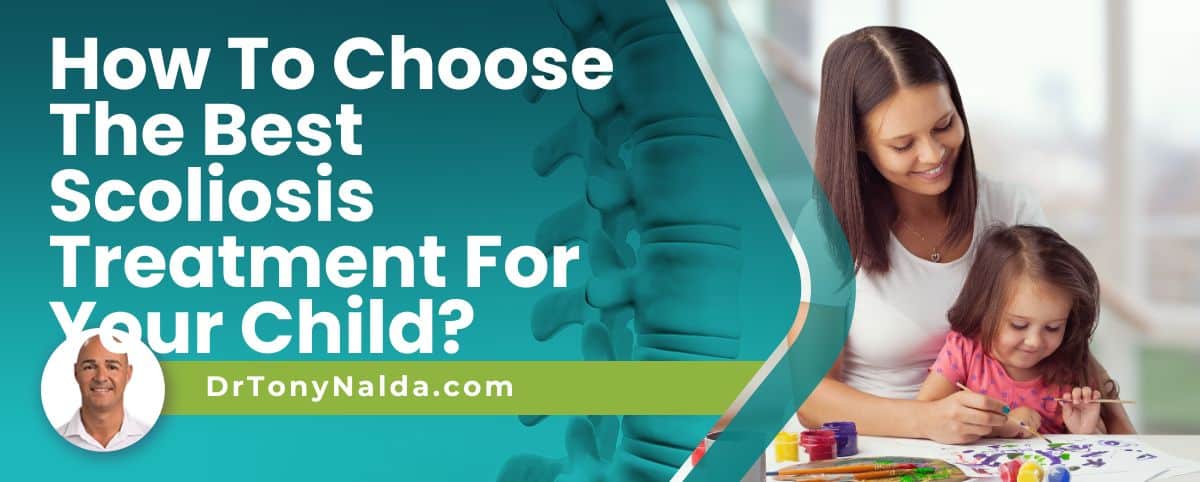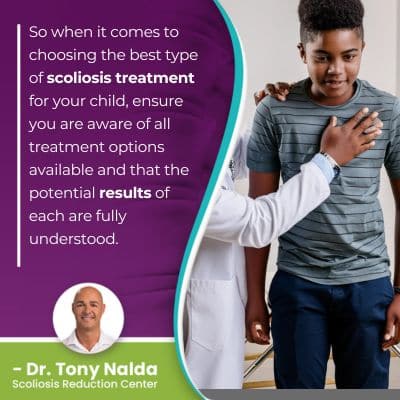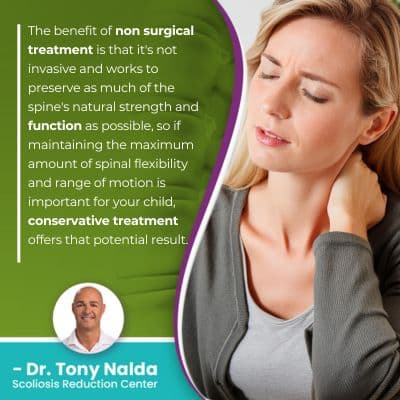How To Choose The Best Scoliosis Treatment For Your Child?

The most important decision to be made following a scoliosis diagnosis is how to treat it moving forward. Different treatment approaches shape spinal health differently, and the choice of traditional over conservative treatment can shape long-term spinal health and function.
Childhood scoliosis needs to be taken seriously as growth triggers progression, and scoliosis progressing means it's becoming more severe and complex to treat. When it comes to choosing the best treatment option, being proactive is key, and this is where modern conservative treatment comes in.
Parents and caregivers need to make sure they are educated on the different treatment options available so they can make an informed treatment choice.
Table of Contents
Childhood Scoliosis Types
While scoliosis affects all ages, it is most commonly diagnosed in children, and while we don't know what triggers most cases for scoliosis to develop initially, we do know that it's growth that makes them progress.
Scoliosis involves the development of an unnatural spinal curve that also rotates, and as a progressive condition, its nature is to get worse over time.
Scoliosis progressing means the size of the unnatural spinal curve is increasing, as are the condition's uneven forces, and their effects.
Scoliosis gets more complex to treat the more it progresses; the spine gets increasingly rigid, making it less responsive to treatment, and that's why early detection, while it doesn't guarantee treatment success, does increase its likelihood.
Scoliosis is diagnosed in children of all ages starting with congenital scoliosis.
- Congenital scoliosis develops in utero due to a malformed spine, so babies are born with the condition; it's rare and affects approximately 1 in 10,000 babies
- Infantile idiopathic scoliosis is diagnosed in infants between the ages of 6 months and three years old
- Early-onset juvenile scoliosis is diagnosed between the ages of 3 and 10 years old, and this is the age group I can make the biggest impact with if treatment is started prior to their first pubescent growth spurt
- Adolescent idiopathic scoliosis, diagnosed between the ages of 10 and 18 is the most common type overall, and this age group is the most at risk for rapid-phase progression due to the rapid and unpredictable growth spurts of puberty
Idiopathic Scoliosis
Idiopathic scoliosis is the most common type and means not clearly associated with a single-known cause, and this accounts for approximately 80 percent of known diagnosed cases, while the remaining 20 percent are associated with known causes: neuromuscular scoliosis, degenerative scoliosis, and congenital scoliosis.
Neuromuscular scoliosis is caused by the presence of a larger neuromuscular condition such as spina bifida, muscular dystrophy, and cerebral palsy.
Idiopathic scoliosis is thought to be multifactorial, meaning caused by a combination of variables that can vary from person to person, and while we don't fully understand the etiology of idiopathic scoliosis, we do know how to manage it effectively, and that's by counteracting progression.
 So when it comes to choosing the best type of scoliosis treatment for your child, ensure you are aware of all treatment options available and that the potential results of each are fully understood.
So when it comes to choosing the best type of scoliosis treatment for your child, ensure you are aware of all treatment options available and that the potential results of each are fully understood.
Conservative vs Traditional Treatment
The two main treatment choices are conservative nonsurgical treatment and traditional surgical treatment.
There was a time when traditional treatment was the dominant choice, but that doesn't mean it was the best or only option available, and the success of conservative treatment speaks for itself and proves that not all cases of scoliosis require surgical treatment.
Nonsurgical Treatment Options
Nonsurgical treatment options are what patients of the Scoliosis Reduction Center benefit from.
Conservative scoliosis treatment is proactive and effective, and with an early diagnosis and intervention, there are fewer limits to what can be achieved.
Condition-specific treatment disciplines are combined so treatment plans can be fully customized and adjusted throughout the course of treatment based on how the spine is responding to treatment and growth.
Remember, when treating childhood scoliosis, particularly adolescent idiopathic scoliosis, the focus is on counteracting the constant progressive trigger of growth, and this is worked towards through a curvature reduction on a structural level so the spine's alignment is improved; a challenge is holding the reduction throughout growth.
Physical therapy and scoliosis-specific exercises are a key facet of scoliosis treatment; they help to increase core strength so the spine has more support and stabilization from its surrounding muscles, keep the spine strong and flexible, improve posture, and address any related muscular imbalance.
Corrective bracing is particularly effective on growing spines, so is a regular facet of treatment for childhood scoliosis, particularly adolescent idiopathic scoliosis, and can help by pushing the spine into a corrective position.
Rehabilitation can be ongoing and involves continued chiropractic care and the prescription of scoliosis-specific exercises to further heal and stabilize the spine from home.
The benefit of non surgical treatment is that it's not invasive and works to preserve as much of the spine's natural strength and function as possible, so if maintaining the maximum amount of spinal flexibility and range of motion is important for your child, conservative treatment offers that potential result.
Traditional Surgical Treatment
Traditional surgical treatment involves spinal fusion surgery, and this is a costly, invasive, and risky procedure that should be considered carefully.
Traditional treatment isn't proactive; it doesn't have a strategy for addressing scoliosis while mild so recommends watching and waiting while mild, which is precisely when conditions are at their most treatable; waiting is wasting valuable treatment time.
Spinal fusion works by fusing the curve's most-tilted vertebrae into one solid bone, and this is done so the vertebral bodies can't become more tilted over time (progress), and rods are commonly attached to the spine with screws to hold it in place; this is contrary to the spine's movement-based design.
 In addition, intervertebral discs that sit between adjacent vertebrae to be fused are often removed, and these discs are important structures; they give the spine structure (adjacent vertebrae attach to the disc in between), act as the spine's shock absorbers, combine forces to facilitate flexibility, and provide cushioning between vertebrae so friction isn't generated during movement.
In addition, intervertebral discs that sit between adjacent vertebrae to be fused are often removed, and these discs are important structures; they give the spine structure (adjacent vertebrae attach to the disc in between), act as the spine's shock absorbers, combine forces to facilitate flexibility, and provide cushioning between vertebrae so friction isn't generated during movement.
So removing spinal discs and fusing the spine is invasive and even if successful at straightening a bent spine, fusing it is going to cost the spine in other ways; the most common complaint is a noticeable loss in spinal flexibility and range of motion.
Depending on the number of vertebrae fused, the location of the fusion, and the degree of flexibility left directly above and below the fusion site, some patients find they can't participate in once-loved activities, and a fused spine is weaker and more vulnerable to injury, and for a young person with their whole life ahead of them, this can impact overall quality of life.
Conservative treatment doesn't weaken the spine, it strengthens it, along with its surrounding muscles, and traditional treatment has risks associated with the surgery itself, and the long-term effects to spinal health and function to also consider.
Conclusion
The best way to choose scoliosis treatment for your child is to be educated about the different treatment options available and the pros and cons of each.
Traditional treatment offers a surgical response, while conservative treatment offers a nonsurgical treatment alternative that is less invasive and risky.
Conservative treatment works towards preserving as much of the spine's natural strength and function as possible, which is why it's also commonly referred to as functional treatment; the priority is the spine's long-term spinal health, strength, and function.
Oftentimes, the earliest telltale signs of scoliosis in children are uneven shoulders and hips, and the more severe a condition, the more noticeable the postural changes tend to be, and the more in need for treatment they are; the more severe scoliosis is, the more likely it is to continue progressing and becoming more complex to treat.
Spinal fusion surgery has some unknown long-term effects 30, 40, 50+ years down the road, and remember, the younger a patient is at the time of their fusion, the longer the hardware has to last inside the body, and if the fusion is unsuccessful for any reason, the only recourse is more surgery; surgical risks increase with age.
Here at the Center, I spend a lot of time educating parents and/or caregivers, and young patients themselves, on the different treatment options available because I want patients to ensure their treatment expectations are aligned with the realities of their potential complications and outcomes.
For those wanting to try a more natural and less invasive treatment option for their child, conservative nonsurgical treatment offers a safe and effective form of scoliosis treatment.
Dr. Tony Nalda
DOCTOR OF CHIROPRACTIC
After receiving an undergraduate degree in psychology and his Doctorate of Chiropractic from Life University, Dr. Nalda settled in Celebration, Florida and proceeded to build one of Central Florida’s most successful chiropractic clinics.
His experience with patients suffering from scoliosis, and the confusion and frustration they faced, led him to seek a specialty in scoliosis care. In 2006 he completed his Intensive Care Certification from CLEAR Institute, a leading scoliosis educational and certification center.
About Dr. Tony Nalda
 Ready to explore scoliosis treatment? Contact Us Now
Ready to explore scoliosis treatment? Contact Us Now





